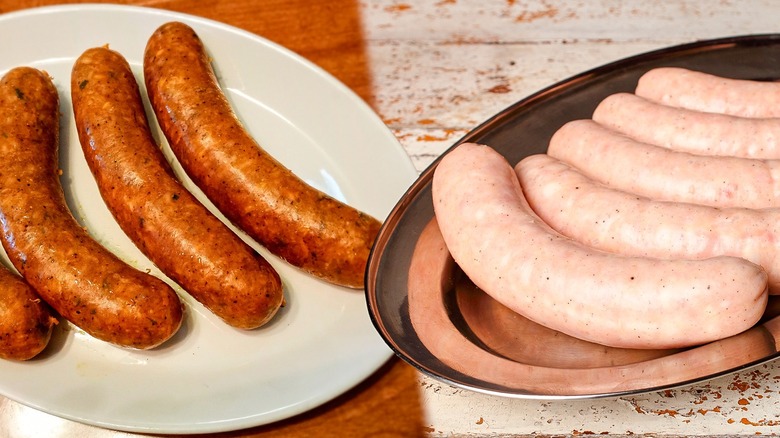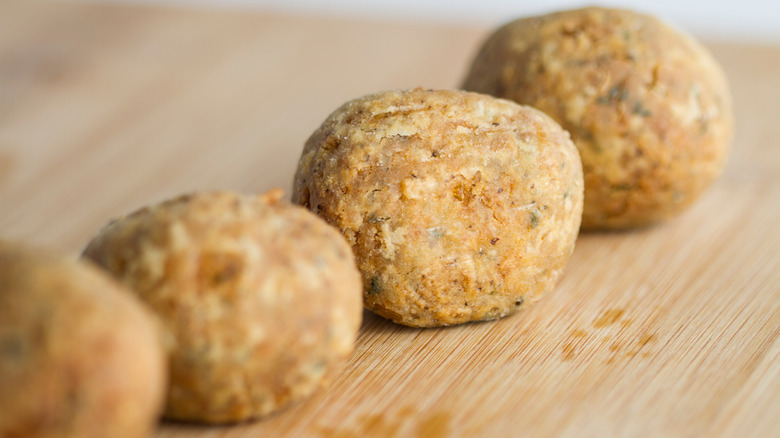Boudin Vs Boudin Blanc: How Do These Sausages Differ?
If you haven't spent much time in Louisiana, it's possible you've never heard of boudin, the seasoned pork and rice sausage that reigns supreme in Cajun Country. But deep in the bayous of Southern Louisiana, everybody and their mama has a boudin stand, each one with a blend better than the next. Like most things in that part of the world, boudin sausage is a convergence of cultures, steeped in history.
Because the Cajun people were born from exiled French Acadians who settled in Southern Louisiana during the 18th century, Cajun food and culture have obvious French influence. However, set in the backdrop of the bayou, their language, cuisine, and traditions were also shaped by the Native American and African cultures that existed the region.
In that way, boudin blanc — a French pork and chicken sausage flavored with milk and Cognac — was transformed into boudin, a well-spiced pork and rice (and sometimes liver) sausage. While the two have little in common these days, it's not hard to imagine how boudin blanc could be the precursor for the famous Cajun boudin.
What is Cajun boudin?
Today, boudin is typically made with pork, cooked rice, celery, onions, and peppers, and it's generously seasoned with bay leaf, cayenne, paprika, garlic, pepper, and oregano. Some boudin-makers also insist on the addition of liver, which provides a more minerally taste. As a matter of preference, some folks aim to make a smoother blended boudin mixture, while others prefer a chunkier version with visible bits of rice and meat. Speaking of rice and meat, the ratio between the two should be close to equal. While the whole flavorful ensemble is cooked and stuffed into a casing, the casing is — more or less — just a temporary binder.
Although some people eat the whole sausage, casing and all, the most common way to eat boudin (after it has been steamed, baked, or grilled in the casing) is to squeeze the mixture out onto toast or crackers. Alternatively, uncased boudin can be added to dishes, piled on top of nachos, or breaded and fried for a local favorite: boudin balls. If you really want to do it like the locals do, try a Cajun breakfast, which consists of a link of boudin and a cold Dr. Pepper! Boudin is an iconic Cajun food you have to try before you die, but you can't order boudin if you don't know how to pronounce it. In Cajun country, it's pronounced similar to "boo-dan," but the "n" is silent.
What's the deal with boudin blanc?
In French, "boudin blanc" translates to "white sausage" or "white pudding." The dish, born in the 17th century in Northern France, is a cased sausage traditionally made with chicken, pork, or veal, as well as cream-soaked bread crumbs, marjoram, sage, and brandy. Unlike boudin noir, which emanates from Southern France, boudin blanc is made sans blood, the ingredient that gives boudin noir (or blood sausage) its dark color. It's also worth noting that the original Cajun boudin, now called "red boudin," actually included pork's blood, although it's much less common.
Often made with the addition of truffles or raisins — foods also native to Northern France — boudin blanc is traditionally enjoyed around the Christmas holiday. The ingredients are pulverized until smooth and uniform then stuffed into hog casing. Sometimes eggs are included in the sausage stuffing for an extra-smooth final product. Traditionally, cooking boudin blanc requires simmering it in water. Once cooked, it can also be browned on the stove top with some butter or duck fat. The sausages can be enjoyed with toast, pickles, sauerkraut, mustard, or potatoes.


